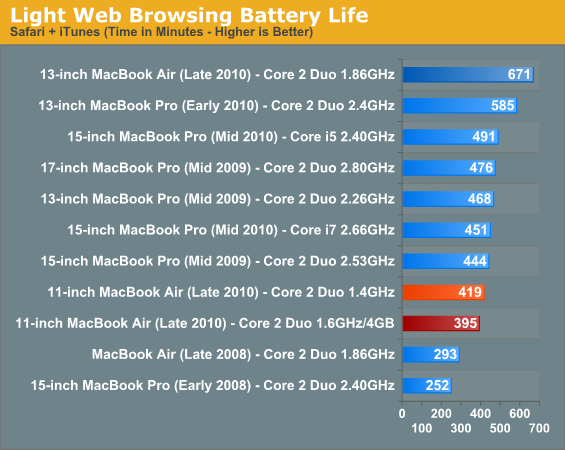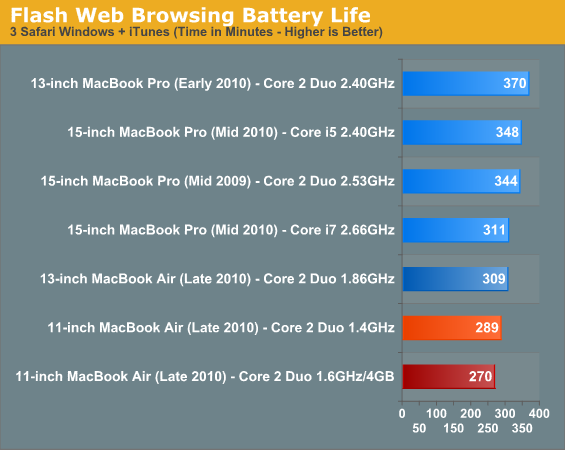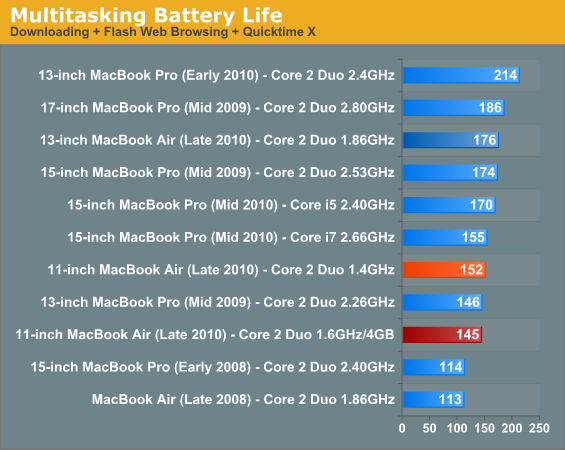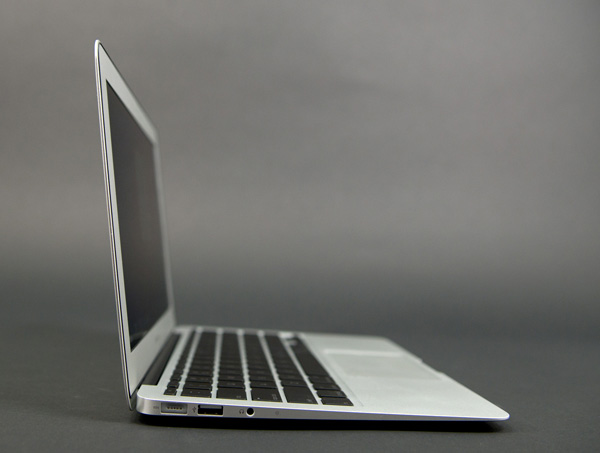Apple's 11-inch Upgraded MacBook Air: Do 1.6GHz and 4GB Make a Difference?
by Anand Lal Shimpi on November 6, 2010 2:35 AM EST- Posted in
- Mac
- Apple
- MacBook Air
- Laptops
Battery Life
Intel ships microprocessors, even those running at the same frequency, at varying voltages. Chips with lower leakage ship at lower voltages, while higher leakage chips ship at higher voltages. All CPUs have to ultimately fit within the same power envelope, but anything below that max TDP is fair game.
Running at a higher frequency generally requires a higher voltage, which in turn increases power consumption. I ran the upgraded 11-inch through all of our battery life tests to measure its impact.
Light Web Browsing
Here we're simply listing to MP3s in iTunes on repeat while browsing through a series of webpages with no flash on them. Each page forwards on to the next in the series after 20 seconds.
The display is kept at 50% brightness, all screen savers are disabled, but the hard drive/SSD is allowed to go to sleep if there's no disk activity. The wireless connection is enabled and connected to a local access point less than 20 feet away. This test represents the longest battery life you can achieve on the platform while doing minimal work. The results here are comparable to what you'd see typing a document in TextEdit or reading documents.

Flash Web Browsing
The test here has three Safari windows open, each browsing a set of web pages with between 1 - 4 animated flash ads per page, at the same time. Each page forwards onto the next after about 20 seconds.
As always, the display is set to 50% brightness, audio at two bars, screensaver disabled and the hard drive/SSD is allowed to go to sleep if idle. The wireless connection is enabled and connected to a local access point less than 20 feet away.

Multitasking Battery Life
Our final battery life test is the worst case scenario. In this test we have three open Safari windows, each browsing a set of web pages with between 1 - 4 flash ads per page, at the same time. We're also playing an XviD video in a window all while downloading files from a server at 500KB/s.

Overall the upgraded hardware resulted in a minimal impact to battery life. The worst impact was in the Flash web browsing test in which the upgraded system delivered 93% of the battery life of the base 11-inch MBA. The remaining two tests offered between 94 - 95%.
Given the 15% average improvement in performance when you need it, a 6% average reduction in battery life isn’t bad.











85 Comments
View All Comments
z4r0sp4c3 - Saturday, November 6, 2010 - link
Apparently during the battery tests, the hard drive is allowed to sleep if idle...? So... always? or never? Is it like dividing by zero?Or simply a copy-and-paste fail.
Anand Lal Shimpi - Saturday, November 6, 2010 - link
:)That's simply what the setting is called under OS X, it doesn't change based on the type of storage in the system unfortunately :)
Take care,
Anand
medi01 - Saturday, November 6, 2010 - link
May I ask who made photos used in this article?bobcpg - Friday, November 12, 2010 - link
Good Question, where did the photo's come from? Seem almost too good...Anand Lal Shimpi - Tuesday, January 18, 2011 - link
I made them :)Take care,
Anand
solipsism - Saturday, November 6, 2010 - link
Anand wrote, “...any way you look at it $1399 is a lot for a lightweight notebook.”Frankly, I don’t expect to pay less for an ultra-portabl than a regular notebook. Note that the original MBA started out higher than this upgraded machine, and the competitors that followed with the SFF LV C2Ds were just as expensive, if not more.
Who else is using the ULV C2Ds from Intel? These new MBAs might be new, but these chips aren’t new.
» http://ark.intel.com/Compare.aspx?ids=36697,37264
The closest competitor seems to be the Sony Vaio X that started at $1300 (and $1500 if you wanted gold colored plastic), but coincidentally dropped their prices by $200 this past Monday, yet still more than the 11” MBA with a processor and IGP that cost 7x(?) as much. How can Sony justify an Atom Z550 CPU + GM500 IGP for that price when the bulk of the cost has been reduced to a $30 CPU and IGP. If you use the extended battery that puts it inline with the 11” MBA in terms of weight and usage, but not in terms of performance.
Anyway you can compare other ultra-portables?
bloodterfly - Saturday, November 6, 2010 - link
You forgot to include the Dell Adamo- thinner, with a similar price, and specs (larger SSD/no 320m)Somehow no longer for sale from dell.com for some reason, was a month ago though. Refresh?
Or the Vostro V13- even cheaper.
The Vaio X is stupid thin. I think it's the thinnest traditional form factor laptop (i.e. adamo xps doesn't count) That's how they can charge so much for it. People pay for extremes.
solipsism - Saturday, November 6, 2010 - link
In regards to the comparisons, I was looking for 11” ultra-portables with CULVs. I can’t find any, which makes me wonder how Anand can say the price is “a lot” when there is nothing to compare it to. If it’s just a personal thing, then there is a lot of history of ultra-portables that are vastly more expensive for performance making the 11” MBA the cheapest such machine he’s tested, that I can find.If you want to talk 13”, I like the styling of the Vostro but it isn’t close to the MBA. It starts with a single core Celeron and moves up to a 1.3GHz C2D. That is 1GHz less than the maxed out 13” MBA. Not to mention the size and weight. It’s an ultra-portable, I guess, but it’s not in the same class as the Adamo, MBA or now defunct Voodoo Envy.
The first Adamo is a well engineered machine. I love the ports in the back. The 2nd design was very poor. There was no benefit to the user. They went thinner without adding functionality. » http://www.dell.com/us/p/adamo-laptops It does look like it even the first generation is gone. Hopefully they something else coming.
Note, that Vaio X is thinner the new MBAs but with an Atom CPU+GM500 IGP and 3 hour battery. Could Sony put the same HW in the MBA in the Vaio X chassis? Is the Vaio X less total volume even though it’s thinner at its thickest point? I think many people underestimate the cost of quality engineering.
mino - Saturday, November 6, 2010 - link
And no light in the tunnel. From Intel anyway. For the sake of performance Sandy will not be much better than Clarkdale in the CULV space.Thank god Ontario is coming soon.
nitrousoxide - Saturday, November 6, 2010 - link
Ontario and Zactate are designated to compete with the "drive-you-crazy" Atom, not the CULV SNB. From preview on SNB destop we can expect 10% higher frequency and 10% higher performance vs. frequency with same power consumption, which means that the new CULV Core Series can provide up to 20% performance boost compared to current models. That is more than enough to overwhelm AMD's first-gen-Fusion APU.